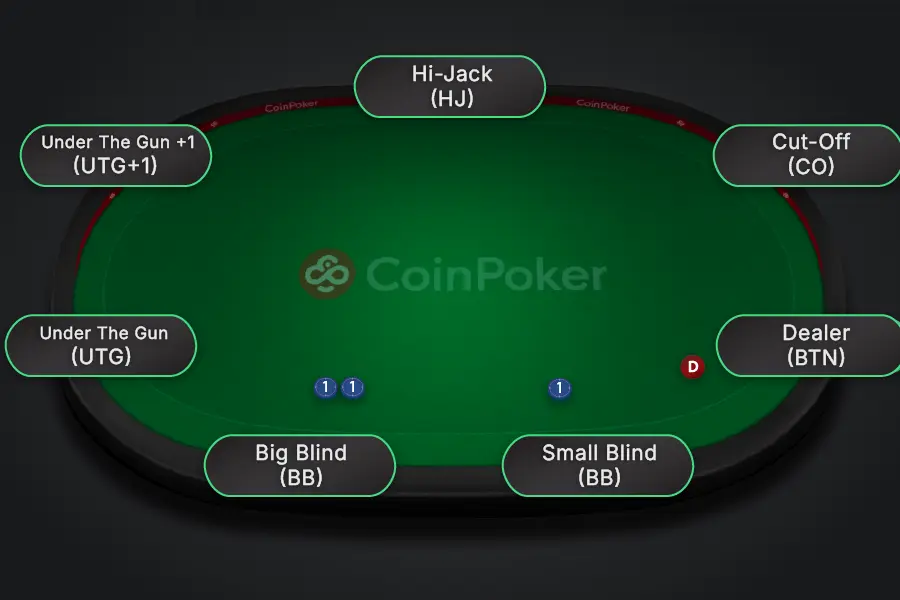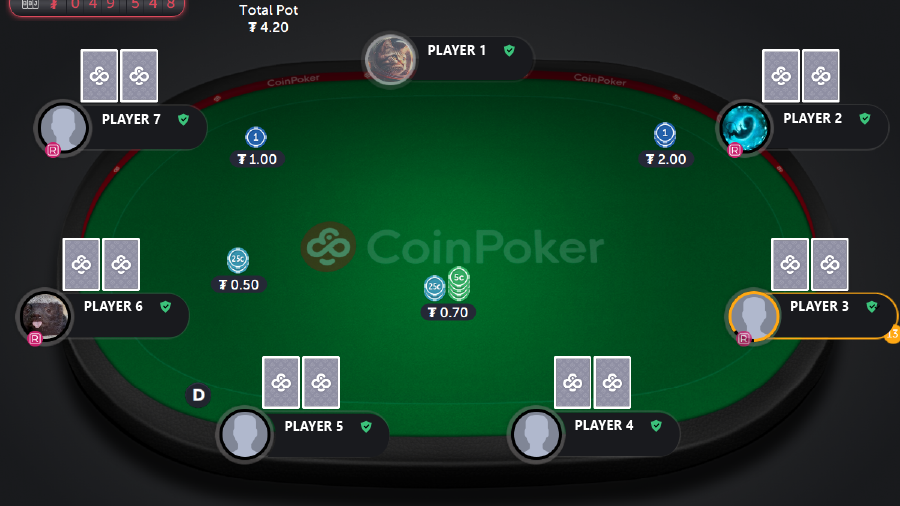Last Updated: 26 August 2025
Poker Blinds: Definition, How to Play Blinds & Best Strategy
Learn all about blinds in poker - how they work in tournaments and cash games, expert strategies for defending and stealing blinds profitably, and more.
StrategyBlinds are the engine that keeps poker games moving. Without them, nobody would have a reason to enter the pot without a premium hand. In this guide, we’ll explain what poker blinds are, where the blind positions sit at the table, and how they work in different game formats. You’ll also learn how to defend your own blinds, attack others, and use blind-related strategies to your advantage.
What Are Blinds in Poker?
Blinds are forced bets that players must post before cards are dealt. They keep the action going and ensure there’s always something to play for. There are two blinds in most games: the small blind and the big blind. These rotate around the table after each hand, moving one position clockwise after each hand of poker.
Why do we have blinds? Without them, players could fold every hand for free. Blinds create an incentive to play and build pots. The small blind sits directly to the left of the dealer. The big blind is left of the small blind. These positions are referred to as the “blinds.” The players in the blinds act last preflop, but first on all following betting streets.

Small Blind (SB) Position Explained
Definition of the small blind:
The small blind, or “SB” in short form, is posted by the player immediately to the left of the dealer button. You must put in half the big blind before seeing your cards. This means if the big blind (BB) is $2, the small blind puts in $1.
The small blind plays second to last before the flop, but always goes first on the flop, turn, and river. It’s a tough position to play from because you’re always out of position post-flop (acting before other players).
Strategically, small blind play is about control. You should be selective and play a tight, but aggressive poker strategy with your hands when entering pots.
Big Blind (BB) Position Explained
Definition of the big blind:
The big blind, or “BB” in short form, is posted by the player to the left of the small blind. Every time it’s your turn in the big blind position, you must put out a full bet, also known as one blind. For example, if you’re playing a game of $1/$2 Texas Hold’em, then the big blind must put $2 out preflop (before receiving hole cards). When you play the big blind, this preflop bet means you’re automatically in the hand unless raised.
During the preflop round, you get the privilege of playing last and seeing other players act. However, on all subsequent rounds, you will be among the first to take action. The small blind is the only position to play before you.
Since you’ve already paid to see the flop, defending your big blind becomes an important skill. Many players choose to call wider in this spot, but you still need to make disciplined decisions post-flop.
How Do Blinds Work in Poker Games?
Now that we know what poker blinds and their positions are, let’s look at how they function in different online poker games. From tournaments to cash games to heads-up play, blinds shape the action and strategy.

How Blinds Work in Tournaments
In poker tournaments, the cost of the blinds increases over time. They may start at 1/2 for example, but will slowly increase to 2/4, then then 5/10, and so on. They’re designed to push the action and eventually force players to go all-in much more liberally.
As blinds rise, your stack becomes relatively smaller. That’s why position, timing, and aggression are key in tournaments. You can’t sit back and wait forever, especially since you can’t reload chips. Players often find themselves short-stacked, which makes blind defense more about survival than profit.
How Blinds Work in Cash Games
In cash games, poker blinds stay constant unless you change stakes. If you sit down at a $1/$2 Pot Limit Omaha game (or other cash game formats), the stakes never change. Since cash game blinds don’t escalate like they do in tournaments, there is less pressure. Instead, players can stick to fundamental strategies and can also rebuy at any time. Blinds still drive the action, but players have more flexibility with their stack and timing.
Most players enter cash games by waiting for the big blind to come around instead of posting early. Entering early means paying one blind, and possibly being in a bad position. So, most players enter the game from the big blind position, eliminating that disadvantage. This is known as “waiting for the blinds.”
What is Straddling in Cash Games?
A straddle is a voluntary blind bet made before the cards are dealt, usually double the big blind. It’s often placed by the player under the gun. This action is reserved for cash games and you’ll never see straddles in tournaments.
Straddling builds bigger pots and changes the dynamic of the hand. However, it also commits you to the pot with a random hand. This is the downside to straddling in poker games. Some players use straddling to create a loose image or to build large pots, but it’s generally not a profitable poker strategy. Professionals avoid straddling and it’s more common to see in casual home games or live-streamed cash games.
How Blinds Work in Heads-Up Games
In heads-up poker, the small blind is also the dealer and acts first pre-flop. The big blind acts second pre-flop but first on all other streets (flop, turn, and river). This is the reverse of full-ring games. Many players find this confusing at first.

Playing the Small Blind in Heads Up Games:
The small blind goes first in heads up games. Playing from the small blind, you should be raising with at least 80% of your hands, putting pressure on the big blind. Against opponents who fold too much, playing every hand from the small blind becomes a profitable endeavor.
Playing the Big Blind in Heads Up Games:
As the big blind in heads up games, you should defend against raises a lot. Call with all your suited hands, and re-raise with the top of your range and a good variety of offsuit combinations that aren’t strong enough to just call with. Fold only the weakest hands in your range against small raises, and increase your folding range against bigger raises.
The small and big blind positions change every hand, like poker positions in larger table sizes. Because of the constant pressure, you need to play a wider range and defend blinds more aggressively. There’s no place to hide when you’re only facing one opponent.
How to Use a Poker Blinds Calculator
A poker blinds calculator helps you manage your chip stack relative to the blinds. It’s often used in tournaments to figure out your “M-ratio” or big blind count.
To use one, follow these simple steps:
- Input the number of players
- Input the blind level duration and starting chips
- Receive a breakdown of chip stacks per level
The blind calculator allows you to quickly calculate the average chip stack at different stages of the tournament. By being aware of the blind levels and the relation of your chip stack to them, you can build a better overall strategy. Professional poker players always count the number of big blinds they have, rather than focusing on the overall number of chips in isolation.
How to Defend Your Blinds in Poker – 3 Best Strategies
Blinds are mandatory bets that bring a positional disadvantage during poker hands. But that doesn’t mean you have to lose chips every time. While it’s true that these are challenging positions to play from, there are effective ways to counter them.
Let’s look at three essential strategies for defending your blinds.
Tip #1: Know Your Opponent
Not every opponent deserves the same defense. If a player is tight, you don’t need to protect your blind as often. Against frequent raisers, you’ll need to call or 3-bet more. Pay attention to their position as well. A raise from the cutoff is more suspect than one from early position. You should construct your defending ranges for each position at the table and adjust for different player types. Also, remember to keep the stack size in mind, as it can have a huge impact on optimal defending ranges.
Tip #2: Widen Your Range in the Big Blind
You’ve already invested chips in the big blind, so you can afford to call with a wider poker range. This doesn’t mean any two cards, but hands like suited connectors, broadways, and even weak aces can be playable. You’re getting better pot odds than any other player, which means you have to play a wider range. If you fold too often, you will be allowing other players to exploit you by raising very wide whenever you are in the big blind.
Tip #3: Don’t Overplay the Small Blind
The small blind is the hardest position on the poker table. You’re out of position for the whole hand. That’s why you should be cautious. Stick to stronger hands when entering pots. And if you do play, consider raising instead of limping to take control. Small blind defense is more about damage control than chip gain, so make sure to play hands aggressively and often take the pot down preflop.
How to Attack & Steal Other Players’ Blinds – 3 Best Strategies
Blinds are vulnerable by design. When you’re in a late position or the button, attacking them can build your stack steadily. Here are three reliable ways to do it.
Tip #1: Steal Often from the Button
The button is the best seat in the house. When it folds to you, raising puts direct pressure on the blinds. You only need them to fold for your steal to work. Look for tight players in the blinds, as they’re less likely to defend. Against tight players, you can open your entire range from the button and expect to win the blinds the vast majority of the time. Even when they do defend, a c-bet will usually take it down.
Tip #2: Adjust Your Raise Size
Smaller raise sizes work well when stealing. They risk less while still achieving the goal. A 2x or 2.2x raise is enough to apply pressure. If you raise too big, you risk bloating the pot or getting called by better hands. That said, the min-raise might not be the most efficient when stacks are deep, which is why a 2.5x to 3x raise can be applied in such situations. This is especially true in cash games, where bigger raises are the norm.
Tip #3: Mix Up Your Steals
Don’t always steal with junk. Mix lower strength hands with medium and strong hands. This balance makes it harder for opponents to play back. If they think you’re stealing wide, they may start calling or 3-betting light. That’s when your stronger hands pay off. A good stealing strategy comes down to having a well-balanced range of hands, which makes it nearly impossible for your opponents to respond correctly.
Ready to Practice Playing Poker Blinds?
Blinds are more than just mandatory bets, they’re central to how poker plays out. If you’re ready to test your skills, CoinPoker offers freerolls, low-stakes tables, and juicy games to join.
Sign up now and practice everything you’ve just learned at the tables. Take not of our strategy advice, and practice both defending your own blinds and attacking your opponents’ blinds from every position at the table.
Join Our Thriving Gaming Community
CoinPoker offers an unmatched poker experience: instant crypto transactions, provably fair gaming, and no verification requirements.
Join CoinPoker and claim a 150% welcome bonus for poker games.
Play Now

Explore More
Announcements
Read recent announcements from CoinPoker about new games, ambassadors, and changes to our platform.
8 PostsGuides
The go-to resource for mastering poker with expert tips and strategies. Whether you're a beginner or a pro, our guides will elevate your skill level.
60 PostsNews
Find the latest poker news from CoinPoker, plus our latest CoinPoker Weekly and Monthly Newsletters. Updates about games, promotions and other exciting crypto news.
90 PostsPromotions
Find the latest coinpoker promotions here. Explore the crypto poker world with the best poker promotions available.
1 Post
















